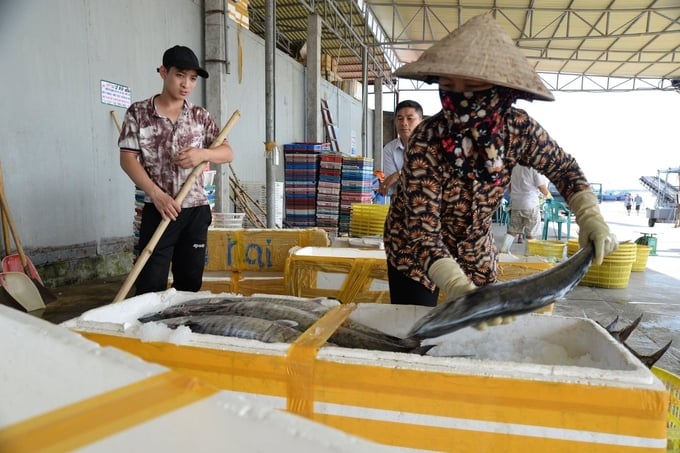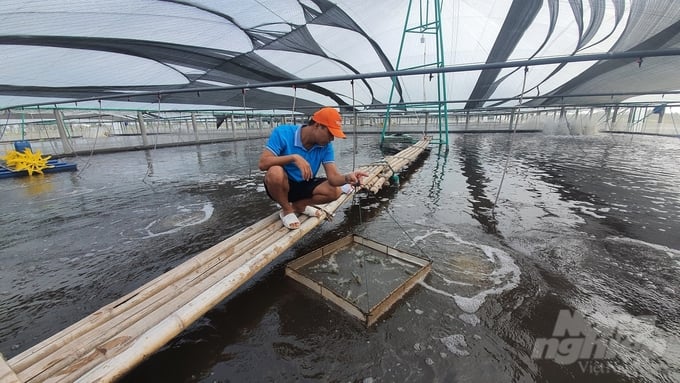November 27, 2025 | 11:54 GMT +7
November 27, 2025 | 11:54 GMT +7
Hotline: 0913.378.918
November 27, 2025 | 11:54 GMT +7
Hotline: 0913.378.918

Nam Dinh fishermen return to port after a trip offshore. Photo: Huy Binh.
According to the Plan for using and exploiting marine resources to 2030, with a vision for 2050, the Nam Dinh Provincial People's Committee determined that marine resources and the environment are important resources for the province's economic development and must be exploited and used effectively and sustainably. Developing the marine economy in a direction associated with environmental protection, biodiversity conservation, responding to climate change and rising sea levels, developing a blue ocean economy; sustainable exploitation and use of resources and protection of the marine environment.
By 2030, the province's marine resources will be exploited reasonably, used effectively and fairly; marine environmental pollution will be prevented and controlled; marine and coastal biodiversity will be protected, maintained and restored.
In particular, marine and island resources are exploited reasonably and used effectively for the rapid and sustainable development of marine economic sectors. Nam Dinh's number 1 priority is aquaculture and seafood exploitation, followed by maritime economic sectors; tourism and marine services; coastal industry; and exploitation of marine mineral resources...
In addition, effective monitoring, control and prevention of marine environmental pollution and pollutants from land and sea, issues of cross-border pollution, marine environmental incidents, and ocean plastic waste pollution... are also emphasized.
According to Mr Hoang Manh Ha, Director of Nam Dinh Fisheries Sub-Department, the zoning of marine space use gradually overcomes conflicts and overlapping interests in resource exploitation and use between units and localities; ensures harmony of interests of the State, businesses, communities and people's livelihoods, ensure that the marine environment, marine and coastal ecosystems are effectively protected, responding to climate change and sea level rise.

Nam Dinh determined that the focus is on aquaculture, limiting fishing for marine farming. Photo: Kien Trung.
Nam Dinh determined that the number 1 goal is to use marine resources to develop a comprehensive fisheries industry in the fields of aquaculture, exploitation, processing and seafood logistics services. By 2030, total seafood production will reach over 230,000 tons, of which aquaculture will reach 170,150 tons, and fishing will decrease to 60,000 tons.
In 2022, Nam Dinh's total seafood output will reach more than 187,000 tons, of which exploitation will reach 58,500 tons; farming will reach more than 128,700 tons. The value of aquatic product production reached VND 5,474 billion, accounting for 28.10% of the structure of the agriculture, forestry and fisheries sectors.
In the first 9 months of 2023, total seafood output will reach over 145,500 tons, reaching 74.68% of the year plan. The entire Nam Dinh province has 1,749 fishing boats; The number of fishery workers is 5,222 people operating on fishing grounds, mainly in the Gulf of Tonkin region.
We have built a system of fishing ports and storm shelters for fishermen. The two fishing ports announced to be open and put into use are Ninh Co Fishing Port (Type I fishing port announced to open port by the Ministry of Agriculture and Rural Development); Quan Vinh Fishing Port (type III fishing port) in Nghia Hung district is in the construction phase.
3 provincial-level storm shelter boat anchoring areas include the Ninh Co River estuary boat anchorage area (Hai Hau district); the Ninh Co River estuary storm shelter anchorage area (Nghia Hung district) has completed phase I and been put into use, waiting for the construction of anchorage lock No. 2; The estuary storm shelter anchorage area at Ha Lan estuary (Giao Thuy district) is being completed and ready for handover", Mr. Ha said.
For the task of combating IUU exploitation, the People's Committee of Nam Dinh province directs the Commune People's Committee and Commune Police to preside with the stations and Border Guard checkpoint checks fishing vessels belonging to the category of "3 no" fishing vessels. They are ships that have not yet installed cruise monitoring equipment, ships with an expired registration, and ships at high risk of violating IUU fishing to ensure that each ship, its owner, and specific anchorage location are known. Unqualified fishing vessels are not allowed to leave their anchorages and are inspected and monitored daily. Fishing vessels with a length of 15m or more must turn on 24/7 cruise monitoring equipment from the time the ship leaves port until the time it arrives at port.
Heads of district and commune levels who allow their local fishing vessels to violate IUU fishing must be responsible to the Chairman of the Provincial People's Committee.
Translated by Hoang Duy

(VAN) On the morning of November 27 in Beijing, Minister Tran Duc Thang and the Deputy Commissioner General of the General Administration of Customs of China signed a protocol on fresh jackfruit exports.

(VAN) As floodwaters recede, a vast network of irrigation works across eastern Gia Lai is emerging in a state of severe disrepair, with extensive damage demanding urgent restoration ahead of the 2025-2026 winter-spring cropping season.

(VAN) The conference reviewing three years of implementing Decision 911 identified the need to prioritize improving marine environmental quality and promoting sustainable fisheries development.

(VAN) Le Hoai Trung, Member of the Communist Party of Viet Nam Central Committee and Minister of Foreign Affairs, held talks with Vi Thao, Chairman of the Guangxi Zhuang Autonomous Region (China) this week.

(VAN) The Mekong River Commission adopts the 2026 - 2030 Strategic Plan with a people-centered approach.
/2025/11/26/1720-1-200855_132.jpg)
(VAN) Viet Nam and Japan have many conditions to expand cooperation on climate change adaptation, particularly in disaster risk management based on advanced technologies.

(VAN) The strong development of digital technology and artificial intelligence is opening up opportunities to transform science and technology into a 'Magic eye' for disaster forecasting and early warning.